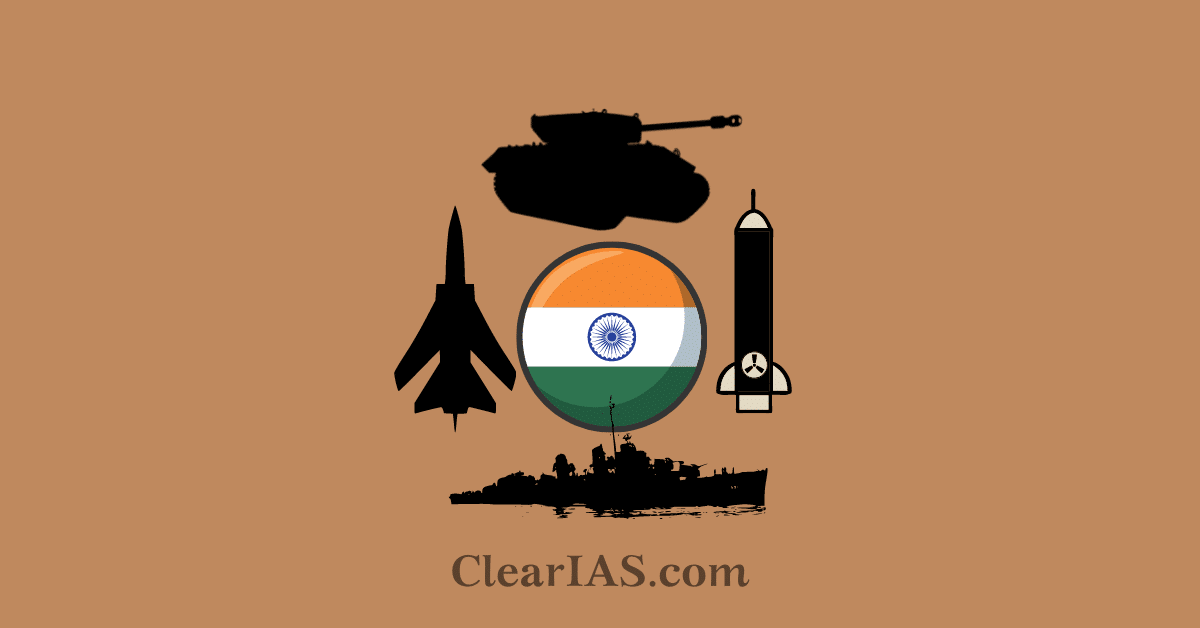

India has been pushing for the indigenisation of the Indian defence sector rapidly. Read here to learn about the history, policies, and present projects under the indigenisation program.
Self-reliance in defence is of vital importance for both strategic and economic reasons, hence building an indigenous defence potential is essential. The presence of robust security architecture is primary for India’s geopolitical ambitions and against hostile neighbours’ actions.
Table of Contents
Subscribe to the ClearIAS YouTube Channel for more informative videos on UPSC preparation, tips, and strategies. Stay updated with our latest content and enhance your exam readiness.
Indigenisation is the capability of developing and producing any defence equipment within the country to achieve self-reliance and reduce the burden of imports. It involves creating an ecosystem to design, develop and manufacture different types of equipment indigenously.
A country like India with its immense potential and strategic location requires to be self-reliant, hence it is important to pursue the idea of indigenisation for:
The conflict with China in 1962 alerted India of her under-preparedness for war which led to increasing the defence expenditure to 2.3% of GDP.
In the Indo-Pak war of 1965, the US imposed an embargo on the export of arms led to the defence ties with the soviet union intensifying.
👉 Which year are YOU targeting for success in the IAS/IPS/IFS Exam? 🚀
But over the years, the overdependence on the Soviet Union for defence equipment had forced a change in India’s approach to defence industrialization from license-based production to indigenous design-based production.
In the mid-1980s, the government started pumping resources into research and development to help DRDO to undertake high-profile projects.
The most relevant development in defence indigenization was made in 1983 when the government-sanctioned the Integrated Guided Missile Development Programme (IGMDP)to develop five missile systems:
In 1990 Self Reliance Review Committee(SRRV) under A.P.J. Abdul Kalam, formulated a 10-year self-reliance plan which proposed a self-reliance index (SRI) (defined as the percentage share of indigenous content in total procurement expenditure), to be increased from 30% in 1992-1993 to 70 % by 2005. This target has not been achieved till today.
The efforts in indigenisation were not enough to meet the requirements of the armed forces, which caused a shift of focus towards co-development and co-production in partnership with foreign companies.
In 1998, India and Russia signed an inter-governmental agreement to jointly produce Brahmos supersonic cruise missiles.
India has also partnered with other countries such as Israel and France for several projects.
INS Vikrant: India’s first indigenous aircraft carrier 1 (IAC 1).
Tejas aircraft: DRDO is trying to develop an indigenous Kaveri engine for the aircraft.
Project 75: Indian navy’s submarine program dealt with France, Germany, Russia, Sweden, Spain, and Japan to build six advanced stealth submarines.
First indigenous Long-range artillery gun, “Dhanush”.
Arihant: India’s first indigenous nuclear submarine by BARC and DRDO
Agni V: The ICBM (intercontinental ballistic missile)
The Pinaka multi-barrel rocket launcher was developed by RDE, Pune.
Supersonic cruise missile Brahmos was developed by a joint venture with Russia.
Arjun tank: the third-generation main battle tank developed DRDO and produced by Indian Ordnance Factories.
The above-mentioned challenges faced by the indigenisation of the Indian defence plan need to be addressed by emphasizing the ‘Make in India’ plan.
“Self-reliance in defence manufacturing is a crucial component for improving defence capability and to maintain national sovereignty and achieve military superiority.” Analyze the statement with respect to defence manufacturing in India.